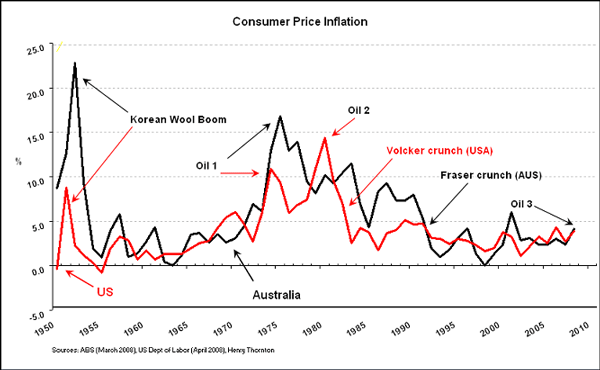Should the anchor keep slipping, a "Stevens crunch" will be needed because of the way inflation has surprised on the upside, both globally and in Australia. Oil and food prices have rocketed, but in the brutal world of macroeconomics this is not yet perceived to be a primary problem, though it may become of primary importance. Certainly the rocketing price of oil is a matter for debate everywhere. "Oil rage" is afflicting Euroland.
People everywhere who cannot afford to eat, or to eat properly, are desperately worried about food prices. Householders are finding rising rents or mortgages more than an inconvenience. People on low incomes are suffering a multiple whammy of expensive food, petrol, housing and money. This makes inflation a major political problem.

Advertisement
The graph puts our current inflation into long-term perspective. Clearly, inflation was far worse at the time of the Korean wool boom or at the time of the first two oil shocks in the 1970s.
Inflation is (so far) nowhere nearly as bad as it was in the early 1950s or the 1970s. Inflation exceeded 20 per cent in the early 1950s and reached a bit over 16 per cent in the 1970s.
The basic reason for current low inflation is that an earlier US Federal Reserve chief, Paul Volcker, bravely broke the stick of inflation in the world's most powerful economy. Falling US inflation led global inflation down. Volcker's brave action reduced inflationary expectations everywhere.
Australian inflation was effectively zero in 1998. This reflected our own monetary crunch - the "(Bernie) Fraser crunch" - a decade after the Volcker crunch.
The effects of this were reinforced by the maximum of imported deflation associated with the rise of China as a major force in global manufacturing.
Ominously, Australia's inflation has been rising since 1998. Inflationary expectations reached a low of around 2 per cent in 1998. The latest reading, for April 2008, is 5.2 per cent. Inflation that matters, especially to people on low incomes, is far above 4 or 5 per cent.
Advertisement
There is cold comfort in the fact that this is a global problem.
In a recent issue The Economist explains: "Inflation's back ..." The world average rate of inflation, it says, has risen to 5.5 per cent, the highest since 1999. Global monetary policy is at its loosest since the 1970s and average world "real" (inflation adjusted) interest rates are negative.
The damage originated in the US, with first Alan Greenspan and now Ben Bernanke creating negative real rates of interest. Massive global liquidity growth was fuelled from the developing economies, whose fixed currencies and purchase of US and other developed nations' assets helped create an asset bubble. Monetary policy is loosest in developing nations, which are now undergoing goods and services price inflation that feeds back into developed nations' goods and services inflation.
Discuss in our Forums
See what other readers are saying about this article!
Click here to read & post comments.